2022 Yamaha YZF-R7 Review - First Ride

Fun and affordability wrapped up in a controversial name
I get it. You’re upset. How could Yamaha possibly perform something as sacrilegious as this? The name YZF-R7 belongs to one of the most iconic motorcycles in Yamaha’s history. A 750cc screaming inline-Four that was basically purpose-built for racing, with looks that have stood the test of time, the original R7 is a legend. To put it on this – on this – is simply unforgivable.
2022 Yamaha YZF-R7
| Engine | 17.0/20 |
| Suspension/Handling | 12.0/15 |
| Transmission/Clutch | 8.0/10 |
| Brakes | 7.5/10 |
| Instruments/Controls | 3.5/5 |
| Ergonomics/Comfort | 8.0/10 |
| Appearance/Quality | 9.0/10 |
| Desirability | 9.0/10 |
| Value | 10.0/10 |
| Overall Score | 84/100 |
Am I right? Does the description above apply to you? I have news for you: You’re probably not Yamaha’s target audience with the new, 2022 YZF-R7. In fact, the new R7’s target audience were literally babies when Noriyuki Haga was sliding the old R7 all over the world chasing a World Superbike title. That was 20 years ago, people. It’s time to move on. If it weren’t for all the backlash about the name, today’s crop of up-and-coming sportbike riders probably wouldn’t have even known about the original R7.
Easily the most controversial new model of 2021, the certain uproar over calling it R7 certainly wasn’t lost on the folks from Yamaha when it came time to pick a name. But there’s a method to this madness, and to understand the thought process behind the name is to understand the sportbike world since July of 2008. Allow me to explain.
A Different Time
July 2008 was the peak of the sportbike wars, the height of the two-year update cycle when every manufacturer would refresh their 600s and 1000s in a game of one-upmanship, both on the racetrack and in the showroom. Sales of the R6 and R1 hit their highs in July of 2008 with nearly 29,000 combined units sold that year.
Then the financial crash happened. Motorcycle sales tanked and the industry hasn’t been the same since. The sportbike sector took an especially deep hit, and just like that, the two-year refresh cycle was gone. OEMs went from non-stop development to simply figuring out how to stay afloat. Fast forward to December of 2020, and Yamaha’s R1 and R6 sales were down 78% from the peak in July 2008.
The reasons are plenty, but a big one is price. Over the past 20 years, R1 prices have gone up 70%, while R6 prices in that same timespan grew 53%. Meanwhile, used bike sales for the R6 have shot through the roof. What incentive does a potential R6 buyer have to buy a new one when used ones are a dime a dozen and a fraction of the cost? From a dollars and cents standpoint, continuing with the production of new R6 models really wasn’t making much financial sense for Yamaha, and with pending Euro 5 regulations looming, pouring resources into modifying the R6 to pass would ultimately lead to yet another higher price tag. The nails were starting to set on the R6’s coffin, and as we all know, Yamaha made the decision to axe the R6 from its lineup.
Where Do We Go From Here?
There has been a small but noteworthy bright spot in Yamaha’s R line – the R3. Sales of the R3 have been strong since its introduction, and the driving factor behind it is simple: it’s affordable and easy to ride.
Traditionally, the next logical progression for the R3 rider would have been the R6. But there’s a discrepancy here. The R6 has always been a high-strung, hard-edged sportbike, meant to rev to the moon and slice every last apex. The hard reality is that 95% of sportbike riders will never take their bike to a racetrack. The real-world demographics for riders shopping in the 600cc category are pretty telling, as Yamaha found out during its many focus groups.
What it comes down to is this: riders in the supersport category are relatively new riders (less than six years of experience, according to their data), who like the appeal and the looks of the supersport class, but they’re broke and can’t afford to buy a new one. Not surprisingly, they’re overwhelmingly young males who have never been to the track but consider themselves aggressive riders.
What’s more telling among this group of riders is their preference for supersports despite the existence of bikes like the MT-07. The supersport image was a big draw, and despite what we motojournos say about middleweight naked bikes being more practical, comfortable, and usable, the fact is they simply don’t look as cool. Here’s the thing: the vast majority of these riders are never getting the most out of a 600cc engine because all the power is at the top of the rev range. They like the (perceived) power of a 600 because they’re typically sitting in its non-existent midrange.
You know what bike also has the same, if not more, usable power in the low to midrange? The MT-07.
At the same time, riders in the sub 400cc supersport category are there because this is their first bike. There’s a much higher count of female riders among this group, and all of them are drawn to the class because these little bikes offer the sporty looks they like while they’re doing their daily commute. When it’s time to move up, they often pick a supersport and then join the category of riders above.
In short, the bike Yamaha needed to make to fill the void left behind by the R6 was a sporty motorcycle with the R-series looks to get that all-important curb appeal, but with usable power and performance the average rider could actually tap into but won’t grow out of quickly like the R3. Most of all, it needed to be affordable.
Enter The R7
We’re talking, of course, about the new YZF-R7. Coming in at $8,999, it represents a much more affordable sporty option than others in the category. Yes, it’s largely an MT-07, but no, it’s not just an MT-07 with full fairings. More on that in a moment, but let’s get back to the name. If you’re up in arms about the name, don’t think this discussion wasn’t had internally at Yamaha. Nobody knows the history and significance of the R7 more than the people who made the bike in the first place.
Ultimately, it came down to a few things:
- Yamaha sportbikes are synonymous with the R badging. It’s been this way since 1999 (and if you still have fond memories of the FZR series before it, you definitely aren’t the target audience). Young riders coming up have only ever known Yamaha sportbikes as having the R prefix.
- Renaming the entire lineup to accommodate a different name for the R7 didn’t make sense.
- Again, the last R7 was two decades ago. The revival of the name represents a new generation. It’s done all the time in the car world.
- Once you ride the new R7, you really won’t care what it’s called. It’s fun. (My words, not Yamaha’s, although they’d obviously be inclined to agree.)
Never before have I taken this long to explain the name of a motorcycle before ever talking about the nuts and bolts of the bike, but the genesis of this particular motorcycle was important to explain in order to get a better understanding of just what Yamaha has brought to the table – a better MT-07. And that’s not a bad thing.
So, what do we have with the R7? For starters, the frame, swingarm, and yes, the 689cc parallel-Twin engine with its 270° firing order, are the same pieces you’ll find on the MT. This engine has always been a favorite since it first appeared in the FZ-07 thanks to its broad torque curve and the cool sounds it makes from the exhaust. It has changed the way at least I think of parallel-Twins of the past and their sewing machine-like noises – a result of their 180° firing order. Best of all, it makes usable power accessible to the everyday rider – exactly what Yamaha were aiming for.
There is one significant difference between the R7 engine and the one in the MT (and Tenere 700). For the first time in the CP2 engine, Yamaha has fitted an assist and slipper clutch. The nature of sport riding means aggressive (or sloppy) downshifts are more common. Having a slipper feature to help prevent or reduce the amount of rear wheel hop will come in handy. As a convenient byproduct, this allows lighter clutch springs to be used, resulting in a much lighter clutch pull.
Other small differences include a reshaped radiator tank and cooling fan cover to accommodate the inverted fork, and the battery is also the same one used on the R6, which is smaller and lighter than the MT-07’s battery.
The bigger differences are found in the chassis. We said earlier the frame and swingarm are the same as the MT-07, but there are still key changes Yamaha made to stiffen it up and make it more agile. The move to the inverted 41mm KYB fork with preload, compression, and rebound adjustability is the clearest visual change. More than just a fork swap, the new fork also brings with it triple clamps with reduced fork offset (35mm vs. 40mm) a wider center-to-center distance (210mm vs. 190mm), and stiffer springs at both ends compared to the MT.
More geometry changes include a steeper rake angle, less trail, and a shorter wheelbase compared to the MT-07. Further back, the aluminum center braces are stiffer for more torsional rigidity. Rear ride height is raised by repositioning the rear shock link, and the rear subframe is tweaked a little, too. All of these changes contribute to making the R7 a sharper, more stable sportbike than the MT, while giving better feedback to the rider, too.
To get a better idea how the R7 stacks up, check out this little chart below to get some side-by-side-by-side comparisons:
| Model | R7 | R6 | MT-07 |
|---|---|---|---|
| Rake | 23.7° | 24° | 24.8° |
| Trail | 3.46 in. (88mm) | 3.81 in. (97mm) | 3.54 in. (90mm) |
| Wheelbase | 54.9 in. (1395mm) | 54.1 in. (1375mm) | 55.1 in. (1400mm) |
| Seat Height | 32.9 in. (835mm) | 33.5 in. (850mm) | 31.7 in. (805mm) |
The change in fork also brought with it an upgrade to radial-mount Advics front calipers with 30mm and 27mm pistons. They’re clamping on 298mm discs (same as the MT-07) but are fed fluid through a Brembo radial master cylinder. The lines themselves are rubber, but hey, it’s a $9000 bike. ABS comes standard and, unfortunately, can’t be turned off.
If there was one thing that was clear from the feedback in the focus groups, it was the strong attraction to the sportbike styling. In a way, this made designing the exterior of the R7 relatively easy, as Yamaha has a clear design language with the R-series motorcycles from which to borrow. Horizontal lines flow from front to back, giving the eyes no real hard spots or creases to pause on. Borrowing the M-shaped intake duct from the M1 MotoGP bike was an obvious choice, though the LED center light ruins any real functionality it could have. No bother – the engine doesn’t utilize ram air anyway.
The front profile was an area Yamaha focused on, as the nature of a parallel-Twin engine means it’s very narrow. “Skinny proportions” then became Yamaha’s target, as it packaged the bodywork tightly around the engine. The result, says Yamaha, is the most aerodynamic – and the most narrow – R-series bike ever, and that includes the little R3.
From a rider’s standpoint, the rider triangle between the R7 and R6 places the seat-peg relation in similar spots, but the bars are a tiny bit higher on the R7 compared to the R6. This still gives the rider a definitive sport-riding position, but with a little less commitment than the R6 of yore (it still feels weird writing that). Despite the relatively high seat height, the narrowness of the bike makes it easy to reach the ground, move around, and get into a full tuck.
Alright Already – What’s It Like To Ride?
In a word: fun. Just like its adventure-rooted stablemate the Ténéré 700, The R7 is elemental motorcycling at its best. You have an engine and a throttle. There are no ride modes, nor are there any rider aids except for ABS. It’s you and the machine. And it’s glorious.
Ok, I lied just a little. The bikes we were riding were equipped with the $199 optional quickshifter. It’s only for upshifts, and only works in the standard shift pattern (sorry reverse shift lovers), but it’s an option everyone should spring for as it just makes sense.
Spanning a little over two miles, with a mixture of steep elevation changes, long, sweeping corners, blind entries, and one particularly hard braking zone, our test grounds at Atlanta Motorsports Park proved to be the perfect venue to see what the new R7 could do. With about 75 horses on tap, the Yamaha won’t give an R6 a run for its money, but the difference is how accessible the power is in comparison. The R7’s healthy midrange is very easy to tap into and utilizing the quickshifter will help ensure you’re there as often as possible. This kind of power is still exciting for experienced riders, but riders graduating from smaller bikes will still feel a sense of familiarity they wouldn’t otherwise if they had to rev a traditional supersport north of 10,000 rpm.
Throughout my time on the track, there were some key concepts I kept coming back to in my head. Light, flickable, and elemental kept popping up again and again. Changing direction on the R7 couldn’t be easier, as it flicks from side to side with a swiftness I expect from an R3 or other small motorcycle. It truly is impressive how the little geometry tweaks Yamaha made translate to a bike so nimble. Once over on its side in the long sweepers at AMP, the R7’s stiffness and rigidity over the MT-07 is clear. There’s definitely more stability and feedback given to the rider, which is obviously welcome. However, a backbone frame inherently has its limitations, and if you’re looking for a bike to carry on in the chassis department where the R6 left off, you might be disappointed.
Still, there’s plenty of fun to be had on the R7. In a growing field full of electronic this and rider aid that, knowing your right wrist is solely in control of the action is refreshing. This is especially true since the power on tap isn’t overwhelming and is matched nicely to the chassis. It really gives the feeling that you are riding the bike instead of the other way around – a common feeling once you start stepping up the sportbike (and horsepower) ladder. AMP’s final section of corners consists of very long, flowing bends with plenty of real estate that lead you onto the front straight. They can be taken at full throttle in fifth gear, or even sixth gear if you hit the apexes just right. It’s an exhilarating feeling on the R7, but it would border on scary on nearly any sportbike with significantly more power. Get it right on the R7, and it’s insanely satisfying. Get it wrong, however, and you’re not sent into a deep panic. Simply correct and move on. The seating position is surprisingly roomy despite how narrow it is – there’s plenty of room for my 5-foot, 8-inch frame to get into a tuck and hide behind the bubble, with my elbows mostly tucked in front of my knees instead of beside them.
Negatives
For as fun and rewarding as the R7 is, no bike is perfect, and especially not a budget-minded one like this. Rubber brake lines let down the progressive feel the Brembo master cylinder delivers, as the slop and sponginess is readily apparent. It’s not a dangerous feeling by any means, and at least, a switch to steel-braided lines is a cheap and easy fix.
To that end, not being able to disable ABS is another turn-off – at least on a racetrack (we’re still fans of ABS on the street). Admittedly, you have to brake very deep to engage the ABS in the first place, but experienced riders will find that limit quickly and get put off by it. However, in an effort to find a silver lining, this limitation challenges the discerning track rider to brake slightly earlier and/or slightly longer to avoid ABS activation and make the corner. It can be done, and it can be done quickly, so hope is not lost.
Another cost-saving measure is the use of an LCD screen instead of the de rigueur TFT display we’re used to seeing these days. Its use of simple white letters over a black background is clean and elegant, but it can be hard to read in bright or direct sunlight.
On the suspension front, the R7 could get around AMP at a very respectable pace in its bone stock form (minus the R11 Bridgestone tires we used for our track ride replacing the standard S22 street tires). Only minimal changes were made to the suspension, too, but nonetheless, those serious about going quickly around a track would swap the fork internals for something stiffer and the shock would have to be replaced for something with more than just rebound and preload adjustability. Considering how 95% of R7 owners are likely never going to take this bike to the track, the stock components are more than sufficient.
Lastly, the inability to incorporate reverse shift and keep the quickshifter is a bummer. The strain gauge used to cut the ignition wouldn’t work in the opposite direction. This was especially unfortunate as AMP’s final sector incorporates a long, sweeping left, where you’re forced to pick the bike up and slide your toe under for a fourth gear upshift before dropping the bike back on its side. It costs a fair bit of time, but like the other issues above, it’s probably a matter of time before the aftermarket will take care of it and release an autoblip system that works in both directions.
What About The RS660?
The hot topic is how the R7 compares to the Aprilia RS660. First, it’s worth remembering that, despite the optics, the R7 isn’t Yamaha’s answer to the RS. New models don’t just pop up out of thin air because a rival OEM releases a bike. It takes several years to go from a concept to something you can buy at the dealer. The fact the R7 and RS660 were released within a year of each other is a coincidence – but it points to Aprilia noticing some of the same market factors as Yamaha. Price not being one of them, clearly.
However, when judged purely on performance, the Aprilia has more engine than the Yamaha. The power difference is clear, and especially so the more the revs climb. If anything, the R7’s midrange grunt is on par, if not a little more punchy, than I remember on the RS660.
To me, the clearest difference is how light and effortlessly the R7 changes direction. The RS660 is no slouch, but its 24.1° rake and 4.1 inches of trail are both a tiny bit lazier than the Yamaha. Of course, the Aprilia wins out with steel brake lines and an electronics package, but the R7 shows you don’t really need fancy TC. Or any TC. Clearly a future comparison test is in order.
Is This The Answer?
Inevitably, there are going to be a lot of people upset with this new R7. It’s unapologetically not the reincarnation of the old R7, nor is it really a true successor to the R6. But a look at the supersport category over the past decade or so will show prices have gone up and sales have gone down. People just aren’t buying new supersports. Honda axed the CBR600RR (at least in America), Triumph did the same with the Daytona 675, and the MV Agusta F3 675 quietly disappeared, too (though it’s still around in 800cc form). Suzuki hasn’t done much with the GSX-R600 in ages, which leaves Kawasaki’s ZX-6R basically alone in the class. At the same time enthusiasm for Aprilia’s RS660 is high, despite its price tag.
The formula is much the same for this new R7; this is elemental sport riding distilled to its finest points, wrapped in a package that’s attractive – both visually and financially. Whatever you think of the name, the R7 is a fun motorcycle – no matter your skill level – and its $8999 is certainly very attractive. Dismissing it right off the bat is doing a disservice.
If you ask me though, the R7 does not fill the performance gap between the R3 and the R1. Jumping from the R3’s 40ish horsepower to the R7’s 70ish is one thing, but add another one hundred horses (not to mention the better brakes, chassis, and electronics) when making the jump from the R7 to the R1 and you’ve still got a very steep learning curve.
Join the discussion with other Yamaha R7 fans at the Yamaha YZF-R7 Forum
To me (and to other internet keyboard warriors the world over) the answer is hiding in plain sight – the MT-09. Put the R-series treatment on the MT-09. A future R9 will not only add a logical fourth step to the R-series ladder, but it’ll also take all the fun of the R7 and crank it up to 11. Hear that Yamaha? You could have two(!) home runs on your hands.
2022 Yamaha YZF-R7
+ Highs
- Incredibly light and flickable
- Very attractive price tag
- Elemental sport riding at its finest
– Sighs
- LCD screen can be hard to read
- ABS can’t be turned off (at least not with a button)
- Some corners of the internet will focus on the name rather than the bike
In Gear

- Helmet: Arai Corsair-X Nakasuga
- Suit: Mithos Custom
- Airbag: Alpinestars Tech-Air Race
- Gloves: Racer Gloves High Racer
Boots: Alpinestars Supertech-R
2022 YZF-R7 Specifications | |
|---|---|
| MSRP | $8,999 – Team Yamaha Blue – Available from June 2021 $8,999 – Performance Black – Available from June 2021 |
| Engine Type | 689cc liquid-cooled, 4-stroke, DOHC inline twin-cylinder; 4-valves per cylinder |
| Bore x Stroke | 80.0mm x 68.6mm |
| Compression Ratio | 11.5:1 |
| Fuel Delivery | Fuel injection |
| Transmission | 6-speed; multiplate wet clutch; with Assist & Slipper clutch |
| Final Drive | Chain |
| Front Suspension | Telescopic fork; 5.1-in travel, adjustable for preload, rebound and compression |
| Rear Suspension | Linked-type Monocross shock, adjustable preload and rebound; 5.1-in travel |
| Front Brake | Dual radial-mounted calipers, 298mm hydraulic disc, Brembo master cylinder |
| Rear Brake | 245mm hydraulic disc |
| Front Tire | 120/70ZR17 Bridgestone Battlax Hypersport S22F E |
| Rear Tires | 180/55ZR17 Bridgestone Battlax Hypersport S22R E |
| Length | 81.5 inches |
| Width | 27.8 inches |
| Height | 45.7 incnes |
| Seat Height | 32.9 inches |
| Wheelbase | 54.9 inches |
| Rake (Caster Angle) | 23°40′ |
| Trail | 3.5 inches |
| Minimum Ground Clearance | 5.3 inches |
| Fuel Capacity | 3.4 gal |
| Fuel Economy | 58 mpg (claimed) |
| Wet Weight | 414 pounds (claimed) |
| Warranty | 1 Year (Limited Factory Warranty) |
We are committed to finding, researching, and recommending the best products. We earn commissions from purchases you make using the retail links in our product reviews. Learn more about how this works.
Become a Motorcycle.com insider. Get the latest motorcycle news first by subscribing to our newsletter here.

Troy's been riding motorcycles and writing about them since 2006, getting his start at Rider Magazine. From there, he moved to Sport Rider Magazine before finally landing at Motorcycle.com in 2011. A lifelong gearhead who didn't fully immerse himself in motorcycles until his teenage years, Troy's interests have always been in technology, performance, and going fast. Naturally, racing was the perfect avenue to combine all three. Troy has been racing nearly as long as he's been riding and has competed at the AMA national level. He's also won multiple club races throughout the country, culminating in a Utah Sport Bike Association championship in 2011. He has been invited as a guest instructor for the Yamaha Champions Riding School, and when he's not out riding, he's either wrenching on bikes or watching MotoGP.
More by Troy Siahaan




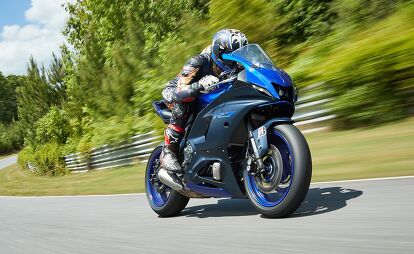



































































































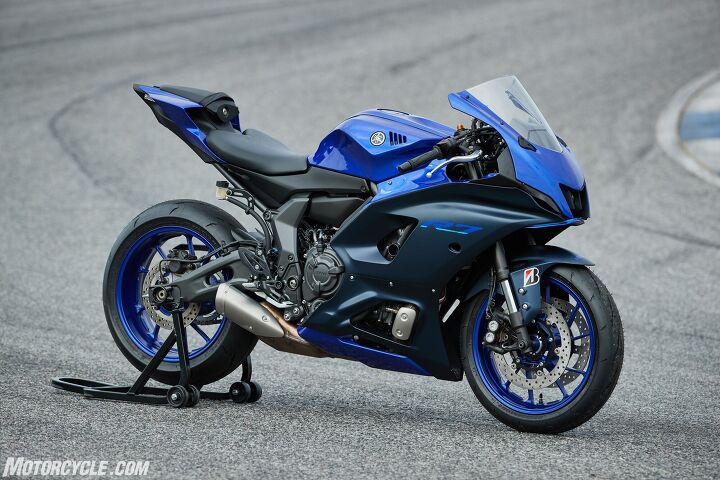



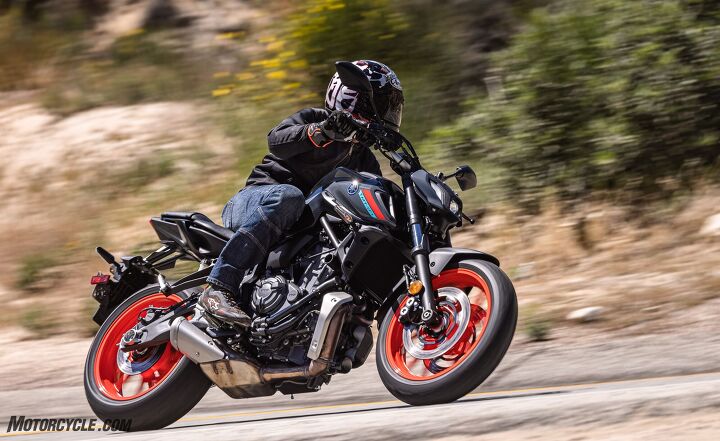












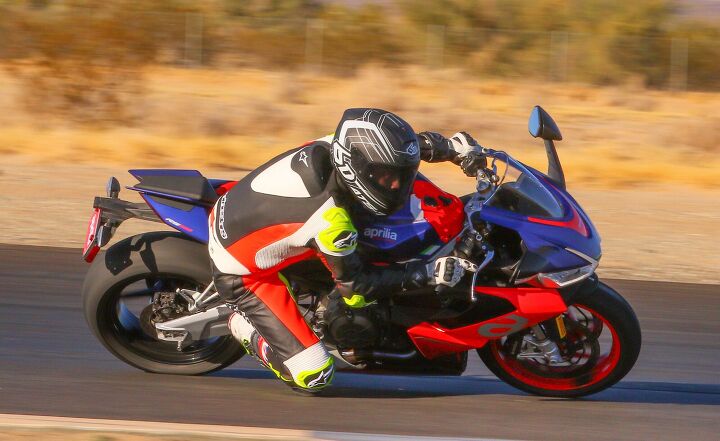





































































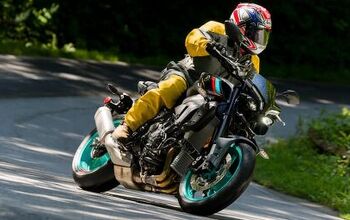
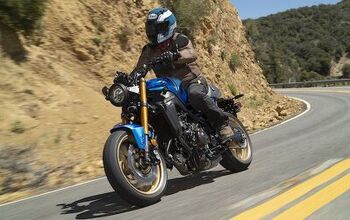
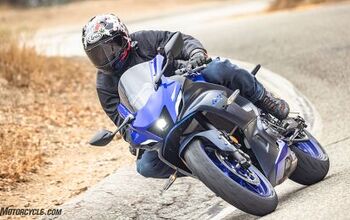
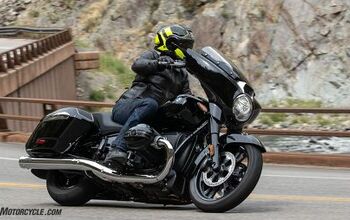












Comments
Join the conversation
Finally, Yamaha has listened to me and used the cp7 in a good looking package. I take full responsability for this one lol.
Now lets go with the other star of their line up the cp9, that would be an epic motorcycle, a daytona on steroids.
"While visually very similar to the MT-07, the side plate on the R7 frame is stronger and stiffer for more torsional rigidity."
Wait a minute! That side plate is legit? I SWORE from looking at it that it was nothing more than a decorative plastic cover designed to look like an alloy frame component and designed to hide an ugly steel frame weld!